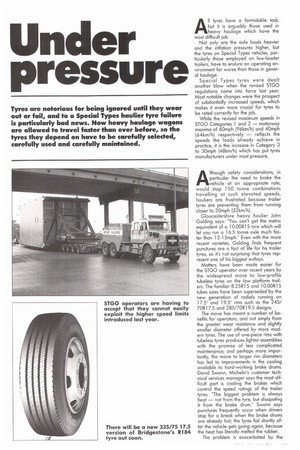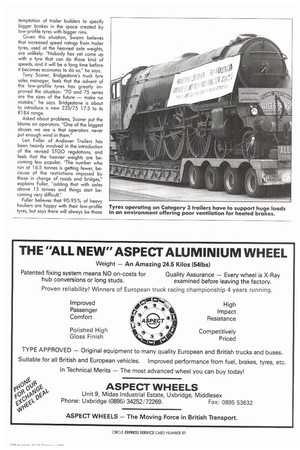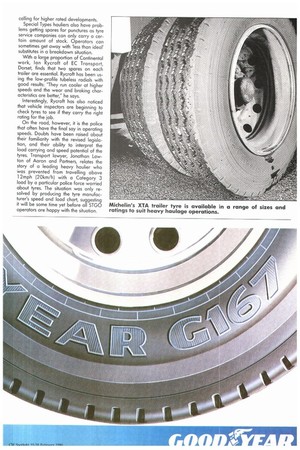Under pressure
Page 74

Page 75

Page 77

If you've noticed an error in this article please click here to report it so we can fix it.
Tyres are notorious for being ignored until they wear out or fail, and to a Special Types haulier tyre failure is particularly bad news. Now heavy haulage wagons are allowed to travel faster than ever before, so the tyres they depend on have to be carefully selected, carefully used and carefully maintained.
All tyres have a formidable task, but it is arguably those used in heavy haulage which have the most difficult job.
Not only are the axle loads heavier and the inflation pressures higher, but the tyres on Special Types vehicles, particularly those employed on low-loader trailers, have to endure an operating environment far worse than those in general haulage.
Special Types tyres were dealt another blow when the revised STGO regulations came into force last year. Most notable changes were the prospect of substantially increased speeds, which makes it even more crucial for tyres to be rated correctly for the job.
While the revised maximum speeds in STGO Categories 1 and 2 — motorway maxima of 60mph (96km/h) and 40mph (64km/h) respectively — reflects the speeds the loads already achieve in practice, it is the increase in Category 3 to 30mph (48km/h) which has put tyres manufacturers under most pressure.
Although safety considerations, in particular the need to brake the vehicle at an appropriate rate, would stop 150 tonne combinations travelling at such elevated speeds, hauliers are frustrated because trailer tyres are preventing them from running closer to 20mph (32km/h).
Gloucestershire heavy haulier John Golding says: "You can't get the metric equivalent of a 10.00R15 tyre which will let you run a 16.5 tonne axle much faster than 12-15mph." Even with the more recent varieties, Golding finds frequent punctures are a fact of life for his trailer tyres, so it's rot surprising that tyres represent one of his biggest outlays.
Matters have been made easier for the STGO operator over recent years by the widespread move to low-profile tubeless tyres on the low platform trailers. The familiar 8.25R15 and 10.00R15 tubes sizes have been superseded by the new generation of radials running on 17.5" and 19.5" rims such as the 245/ 70R17.5 and 285/70R19.5 designs.
The move has meant a number of benefits for operators, and not simply from the greater wear resistance and slightly smaller diameter offered by more modern tyres. The use of one-piece rims with tubeless tyres produces lighter assemblies with the promise of less complicated maintenance; and perhaps more importantly, the move to larger rim diameters has led to improvements in the cooling available to hard-working brake drums. David Swann, Michelin's customer technical services manager says the most difficult part is cooling the brakes which control the speed ratings of the trailer tyres: "The biggest problem is always heat — not from the tyre, but dissipating it from the brake drum." Swann says punctures frequently occur when drivers stop for a break when the brake drums are already hot; the tyres fail shortly after the vehicle gets going again, because the heat has literally melted the rubber.
The problem is exacerbated by the temptation of trailer builders to specify bigger brakes in the space created by low-profile tyres with bigger rims.
Given this situation, Swann believes that increased speed ratings from trailer tyres, used at the heaviest axle weights, are unlikely: "Nobody has yet come up with a tyre that can do those kind of speeds, and it will be a long time before it becomes economic to do so," he says.
Tony Scorer, Bridgestone's truck tyre sales manager, feels that the advent of the low-profile tyres has greatly improved the situation: "70 and 75 series are the sizes of the future — make no mistake," he says. Bridgestone is about to introduce a new 235/75 17.5 to its R184 range.
Asked about problems, Scorer put the blame on operators: "One of the biggest abuses we see is that operators never put enough wind in them."
Len Fuller of Andover Trailers has been heavily involved in the introduction of the revised STGO regulations, and feels that the heavier weights are becoming less popular. "The number who run at 16.5 tonnes is getting fewer, beCause of the restrictions imposed by those in charge of roads and bridges," explains Fuller, "adding that with axles above 15 tonnes and things start becoming very difficult."
Fuller believes that 90-95% of heavy hauliers are happy with their low-profile tyres, but says there will always be those
calling for higher rated developments.
Special Types hauliers also have problems getting spares for punctures as tyre service companies can only carry a certain amount of stock. Operators can sometimes get away with less than ideal' substitutes in a breakdown situation.
With a large proportion of Continental work, Ian Rycroft of EC Transport, Dorset, finds that two spares on each trailer are essential. Rycroft has been using the low-profile tubeless radials with good results: They run cooler at higher speeds and the wear and braking characteristics are better," he says.
Interestingly, Rycroft has also noticed that vehicle inspectors are beginning to check tyres to see if they carry the right rating for the job.
On the road, however, it is the police that often have the final say in operating speeds. Doubts have been raised about their familiarity with the revised legislation, and their ability to interpret the load carrying and speed potential of the tyres. Transport lawyer, Jonathan Lawton of Aaron and Partners, relates the story of a leading heavy haulier who Was prevented from travelling above 12mph (20km/h) with a Category 3 load by a particular police force worried about tyres. The situation was only resolved by producing the tyre manufacturer's speed and load chart, suggesting it will be some time yet before all STGO operators are happy with the situation.
















































































































































































